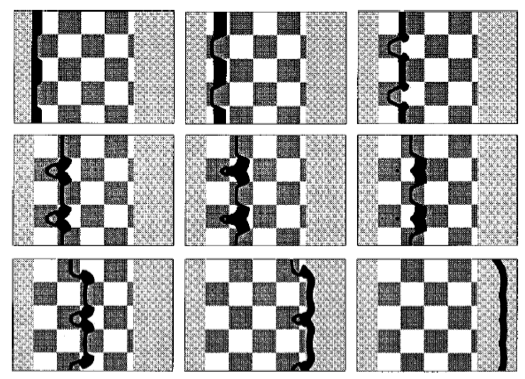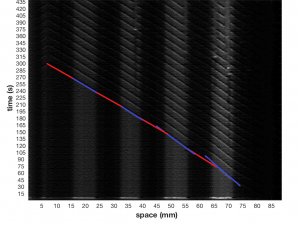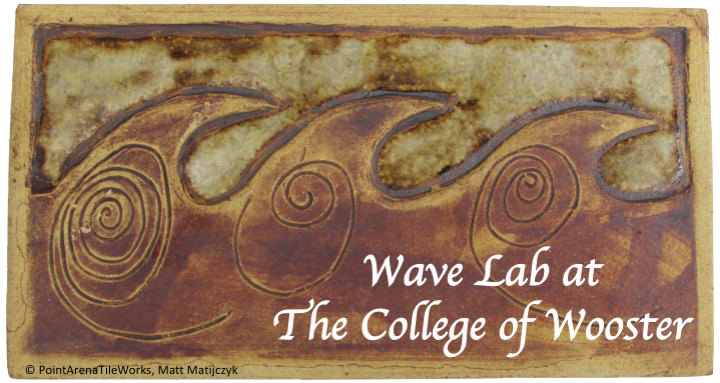
A reaction-diffusion wave’s propagation behavior can be influenced by varying the illumination intensity of visible light (e.g., placing a mask between the light source and the BZ medium or illuminating the system with a projector). Higher light intensity decreases the excitability of the system which decreases the wave’s velocity. Schebesch and Engel (I. Schebesch and H. Engel, Wave propagation in heterogeneous excitable media, Phys. Rev. E, 57(4), 3905–3910, 1998) calculated numerically the propagation behavior of light-sensitive excitation waves in a pure checkerboard-like illuminated system (in the figure from their paper, dark squares are less excitable than bright squares – opposite to the BZ system). One goal is to experimentally prove the predicted behavior.
Spencer Kirn ’16 started this project as his Sr. I.S. He used various checkerboard masks with different gray levels and modulation wavelengths and showed that the theoretically predicted behavior is real.

Daniel Blaikie ’19 investigated the use of various light-sensitive catalysts during the 2018 NSF-REU summer research experience and implemented the use of a projector for better illumination control during his Senior IS in 2018-2019.
We are also working on a 1D-system with alternating excitability to experimentally verify Schebesch and Engel’s 1D-result that, under specific conditions, the wave propagates faster than in a medium with homogeneous mean excitability. It is also expected that propagating waves in a 2D-system survive while their 1D counterparts experience propagation failure at the same system’s “wavelength”.
Other steps planned are varying i) the initial propagation angle, ii) the wavelength-to-inhomogeneity ratio, iii) the light intensity difference ΔI (excitability difference), and iv) the illumination pattern.

Senior Independent Study theses
- Daniel Blaikie ’19: Propagation of light-sensitive RD waves in inhomogeneously illuminated systems
- Spencer Kirn ’16: Excitation waves in planar, inhomogeneously illuminated systems
NSF-REU Summer research
- Veran Stanek – Rochester Institute of Technology (2023): Modeling a Black Hole Event Horizon with a Light Sensitive Belousov-Zhabotinsky System
- Daniel Blaikie ’19 (2018): Propagating Excitation Waves Over a Two Dimensional Illumination Pattern
Poster presentations
- D. Blaikie, S. L. Kirn, and N. Manz: “Propagation of light-sensitive reaction-diffusion waves in inhomogeneously illuminated systems” Spring 2019 Meeting of the APS Ohio-Region Section, Wooster, OH, USA, 2019 March 29-30.
- D. Blaikie, S. L. Kirn, and N. Manz: “Propagation of light-sensitive reaction-diffusion waves in inhomogeneously illuminated systems” APS March Meeting 2019, Boston, MA, USA, 2019 March 6
- S. L. Kirn and N. Manz: “Light-sensitive reaction-diffusion waves in a checkerboard-like illumination system” 47th Central Regional Meeting of the American Chemical Society, Covington, KY, USA, 2016 May 18-21
- S. L. Kirn and N. Manz: “Light-sensitive reaction-diffusion waves in a checkerboard-like illumination system” Spring 2016 Meeting of the APS Ohio-Region Section, Dayton, OH, USA, 2016 April 8-9
